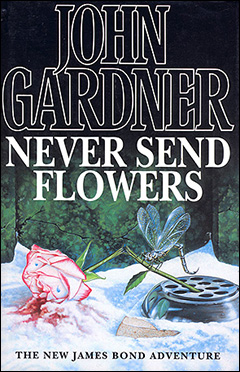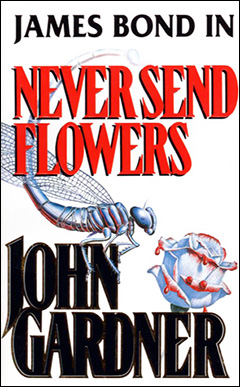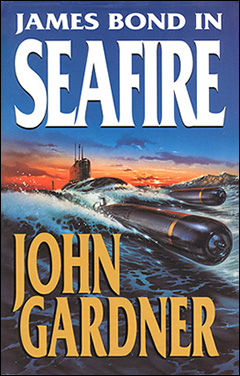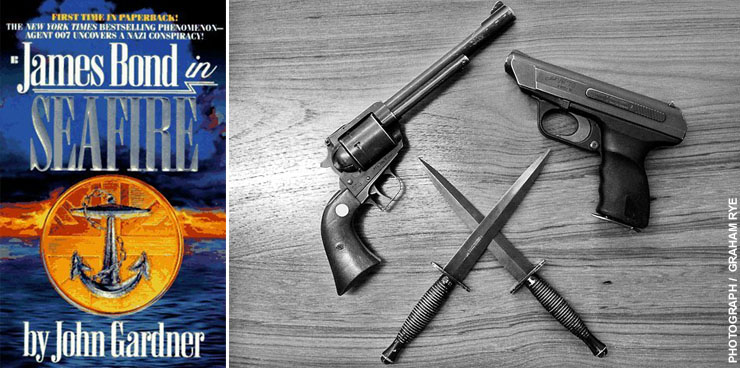 |
 |
NEVER SEND
FLOWERS (1993)
James Bond is on the trail of a serial killer. After four seemingly
unrelated murders in one week (in Rome, London, Paris, and Washington
D.C.), a member of MI5, Laura March, is assassinated while on leave in
Switzerland. James Bond is sent to investigate, since MI6 has
jurisdiction on foreign soil. There, he teams up with Swiss
intelligence officer Fredericka ‘Flicka’ von Grusse, with whom
007 strikes an immediate reciprocal relationship.
After investigating the victim's personal life, Bond and Flicka
learn that she had just broken off an engagement to the once
world-famous actor, David Dragonpol, who retired in 1990 and
disappeared into obscurity. During a visit to Dragonpol's castle on
the Rhine, Bond and Flicka unearth the mind of an apparently sick
individual whose hobby is assassination.
After some close-calls with Dragonpol's servants, Bond and Flicka
pursue the villain to Milan and foil an assassination attempt on a
popular diva. It is then learned that Dragonpol has a twin brother,
Daniel, who has been impersonating David since his “nervous
breakdown”, three years ago. Daniel is killed during a skirmish, but
David fools everyone into thinking he is Daniel and makes his way to
Euro Disney, where he plans to pull off the assassination of the
century - that of Princess Diana and her two sons. |
|
|
Only by using his
wits and some carefully chosen items from Q Branch is James Bond
able to thwart Dragonpol's plans in the middle of the night in the
theme park. Afterwards, M intimates that Bond's assignments within
the service will be changing, and that Flicka may very well become a
permanent partner. (In the original outline submitted to Glidrose
and the publishers, the targets at Euro Disney were “famous rock
stars”, not the Royal Family.) |
|
I enjoyed NEVER
SEND FLOWERS a great deal, mainly because once again John Gardner
has experimented with subject matter and focus. The new Bond novel
is little more than a serial killer thriller. As in SCORPIUS, 007
spends a good deal of the first part of the book doing down-to-earth
detective work. And it's interesting! It's an unusual case for Bond,
and it's precisely what makes the book so appealing.
This is also one of the quickest reads of any of the books. The
story moves extremely well, zipping the reader from chapter to
chapter at a breakneck speed. The author generates a good deal of
suspense. And the character of James Bond is further developed.
Gardner has always tried to inject a little more culture into the
man - and in this book he seems to know a great deal about
theatrical history! Not only is he able to identify correctly scenes
from famous plays, but he can recite lines from them! Some fans may
not be able to buy this, but I happened to think it was fun. The
chase through the Schloss Drache Theatrical Museum is entertaining.
The climax at Euro Disney is perhaps
not quite what it could have been. It takes place at night while the
park is empty. It would have been more exciting if it had occurred
during the day when the park was full of people - but I suppose it
would not have been politically correct to stage the scene in this
fashion. |
 |
|
|
Other characters
are interesting, too. The heroine, Flicka von Grusse, is quite
appealing and odds are that she may become the second Mrs James
Bond. In an unprecedented move, M has allowed her to join MI6, and
she will probably be Bond's partner! This may be blasphemous to some
fans, but their teaming really worked in this novel. I hope the
author can keep up the buoyant repartee between the characters in
the next novel. Once again, though, I find it a little strange that
M and Bill Tanner keep showing up on location - isn't M a bit too
old for that?
David Dragonpol is a great villain - a master of disguise and
deception. It's a pity he isn't used a bit more in the story but the
scenes in which he appears are effective. His strange sister, Maeve
Horton could also have been played up a bit more, but this is a
minor quibble. Most importantly John Gardner has injected more
humour. The book is lighter than one might expect for a story about
a serial killer, mostly due to the presence of Flicka. All in all,
NEVER SEND FLOWERS is a good, fun read and a good indication that
John Gardner has not lost his knack for James Bond. |
|
SEAFIRE
(1994)
Gardner's thirteenth Bond novel incorporates the very many changes
in Bond's world and service which M hinted at in the previous book.
The entire British Secret Service has been revamped. M is no longer
in charge in fact M may well be dying! The Service is now run by a
‘Committee’ of Ministers, Secretaries and other government
bureaucrats. M normally sits on the Committee, as does Bill Tanner,
the former Chief-of-Staff. The old Double-O Section is no more. It
is now called 'two Zeros' and any action it undertakes must be
sanctioned by the Committee - causing all kinds of turmoil in the
way James Bond likes to do things. Any sort of questionable
espionage activity - something like an assassination - is usually
not sanctioned at all. Bond must perform these kinds of acts behind
the backs of his superiors - with the wink and nudging approval of
M.
James Bond has changed as well. He's not the fellow who once smoked
a pack or more of cigarettes and took several alcoholic drinks a
day. He's not the rogue who would sleep with almost any member of
the opposite sex. He's settling down. In fact, he's becoming a bit
mellow. He's taking stock of life and he's not as fatalistic and
cynical as he once was. James Bond is becoming more and more like
someone we all might actually know in real life - which could be a
good thing or a bad thing, depending on how one views it.
|
 |
|
 |
|
Also, in this
novel, Bond is actually living with his female companion from the
previous book, Flicka von Grusse. Now Bond and Flicka are a team of
sorts, as she accompanies 007 through every scene in SEAFIRE, with
only a couple of exceptions.
It's almost as if the Bond series has become The Avengers -
until the reader realises what Gardner is up to. He's setting the
stage for a dramatic event in the next novel: James Bond will most
likely marry for the second time. I have no problem with these
changes. Face it, folks, James Bond is an old guy. In LICENCE
RENEWED the agent's age was never revealed; but the author hinted
that 007 was greying at the temples and was not the 'machine' that
he was in his thirties. I realised as I read SEAFIRE that, while
reading all of the Gardner books, I had subconsciously pictured a
James Bond who was in his late forties at the least, and who is now
certainly into his fifties. That is not the say that Bond is not in
shape - he's a perfect specimen of a male human at that age. He had
to make some lifestyle changes. Everyone at that age must do so, or
they will not remain on the cutting edge. Therefore, if you, the
reader, pick up and read SEAFIRE and imagine a James Bond as a
dashing, strong, brave, tough guy in his fifties, then
everything will make sense. |
|
All of these
changes in Bond's world is what stands out in John Gardner's latest
book. The action-adventure story involving the agent's
investigation, pursuit, and ultimate destruction of the villain Sir
Max Tarn ends up a secondary aspect of the book. This is not to say
it's not a good story either. Sir Max Tarn is one of Gardner's best
villains - a super-rich maniac who believes he will be the new
Fuhrer in Germany. Gardner capitalises on the growing movements of
neo-Nazism in today's Germany.
Tarn, who has been an English citizen since emigrating to the UK
from Nazi Germany in the forties, is now reclaiming his birthright
as the heir to a respected and wealthy German family. Tarn made his
fortune in shipping - then increased it by using his ships for
illegal arms trading.
He has acquired a German U-Boat, which he plans to use off the
shores of Puerto Rico to torpedo an oil tanker so the oil spills in
the bay. Then he plans to use the invention of a trio of scientists
- a device that will miraculously clean up the oil spill. His motive
is to show the world what kind of power he wields. Unfortunately,
the scientists' invention doesn't work yet - so Bond must stop the
torpedo before it kills everyone aboard the tanker and pollutes
Puerto Rico. |
 |
|
|
Gardner keeps the
pace of this rather odd plot going at such a rate that one never
questions what's going on until it's all over - which is pretty much
what lan Fleming did in his day. The action never stops, and the
characters - Tarn himself, his supermodel wife, the henchmen
(including a pair of cross dressers reminiscent of Wint and Kidd in
the film Diamonds Are Forever), and the marvellous Flicka -
are well-developed and completely believable. SEAFIRE, like the last
few Gardner efforts, was a lot of fun to read. |
|
 |
John
Gardner has valiantly carried on in Ian Fleming's footsteps -
certainly no easy task! Looking at the series as a whole places the
oeuvre in a new light. Gardner has stuck to tradition here,
experimented a little there; has written a few passages that don't
quite work, and has created some brilliantly executed moments.
Hardcore Bond enthusiasts who have dismissed the Gardner novels should
give the author a second chance - after all; it is through the Gardner
books that James Bond has lived on into the Nineties. John Gardner has
perpetuated the mythology and added to the folklore. He has breathed
life into a character who was suffering from literary negligence. He
has given us all an entirely new set of tales featuring one of the
most popular characters in fiction. And that, at the very least, is a
major accomplishment. |
|
JOHN GARDNER (1926–2007) |
|
|
|
|
|

